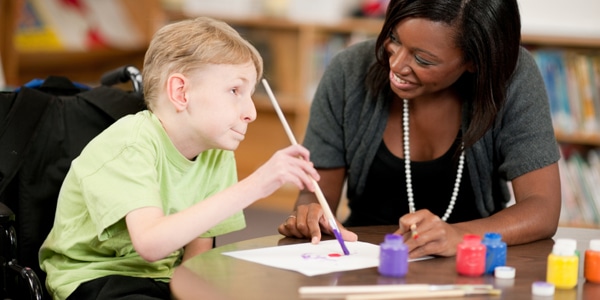Yair Ariel • July-7-2016
Think back on to your early school days. If you were a regular education student, you probably remember a large mix of good things and bad things done by your teachers. Part of a teacher’s job is to shape the behavior of students. This is done through positive and negative reinforcers.

Special needs students
Negative reinforcers is just a fancy word for punishment. Standing in the corner, detention, and earning poor grades are all examples of this. Positive reinforcers includes things like praise, gold stars, and award. Everyone has a natural inclination toward seeking things that give us positive reinforcers and avoiding negative reinforcers.
For special education students, these techniques don’t always work, or at least don’t work in the way that many regular education teachers expect. The various physical and mental challenges of special education students interfere with how regular education expects a normal student to react. That’s one of the reasons why special education teachers get such rigorous training and learn different strategies to deal with their students.
One of the things they learn is that special education students respond very poorly to negative reinforcers. Another thing is that they learn is that positive reinforcers may need to be altered to fit in the special education classroom. We’re going to talk about how to use positive reinforcers to guide behavior for special education students by using a ladder system.
The Ladder System
The way to start is to make a clear system for the students so they can understand how well they’re behaving. One way of doing this is called the Ladder System. It works like this. Everyone starts off at the bottom rung of a ladder. Higher rungs of the ladder get more privileges and rewards. Lower rungs of the ladder require only small changes of behavior of short duration to move up. Higher rungs require larger changes. Each stage of the ladder also has a list of behaviors that could move a student down to a lower level.
Since the goal of special education is to teach children how to transition to regular education, this serves as a great yardstick for students and for administrators to see where they are on that goal. The details of the system are up to each teacher, but it needs to be simple enough that the children can at least understand the level they are on and what could make them move up or down. The lowest levels should also be easy enough that even the most challenged student can move at least one or two levels up through their own effort.
Use physical rewards
Regular education students may be motivated by praise alone, but special education students often need more. Using an assortment of physical items like small toys or stickers as rewards for good behavior or progress in studies provides something tangible for the special education child to link the behavior to the reward. A child with social or behavioral challenge might not believe praise, but getting a toy in exchange for good behavior can get around some blocks.
Some teachers may object that getting toys for simple good behaviors is too much like a bribe, but this is where the ladder system comes in handy. As they move up, simple behaviors that got physical rewards should only get praise where the more complex behaviors should get rewards. Toys can turn into computer game time or unstructured reading time, for instance. You could even invest in a game system like BEAM and reward students with time coupons for use of the system.

Rewards to students
Apply the system justly and explain why
The classroom isn’t a fair place, but it can be a just one. Children are best able to behave when they know the rules and everyone can agree on them. If they can see that rewards and punishments are handed out evenly to others according to strict and clear rules, they will feel like the system isn’t working against them.
When someone moves up or down, explain to the class why so they understand. In the beginning, there may be cries of “that’s not fair”, but if they see the system is applied equally to each student over time, they will accept the “fairness” of the system. Care must be taken to avoid jealousy or envy between students of different levels. A little bit is fine; it can provide motivation to make students want to climb the ladder. But too much will cause problems.
Defend the system from outsiders
As a special education teacher, you must do your best to control your student’s environment to provide the stable and just space they need to learn proper behaviors. Unfortunately, parents and administrators can and do often try to butt in with their own ideas or interfere with the ladder system.
Students at lower levels of the ladder are still trying to get their basic behavior in order. It’s unreasonable to expect them to follow all the rules. Try your best to prevent the regular education student’s rules from overriding the system for your classroom unless the situation is really egregious. Explain the system to administrators and the logic behind it, and show how it can improve student behavior and academic results. The easiest way to show this is to take a baseline of where the student was and compare it to where they are now. Even if that behavior isn’t up to regular education levels, showing the progress can prove the system works.
Help the student at their level
Finally, even if you know intellectually that a student’s deficits will never let them transition you should always try to help them reach the next level. Never let a child think they can’t make it to the top. They may not be able to make it to the top, but the effort they put forth will aid them outside of the classroom.

Help the student
The world may seem very wrong or unfair to a special needs child. As an educator, you have the power to create your own miniature world of rules inside the classroom. Make something that will give every child in there a chance to feel they can move up in the world and feel good about themselves, while also getting the educational and behavioral tools they need to live outside of it.
About BEAM

Beam Gaming Projector
BEAM interactive projector game system is an award-winning interactive projection game system that instantly enhances the experience in your classroom with endless fun, excitement, entertainment and engagement. The system has been helping learning facilities that cater to students with special needs, like the Anderson Center for Autism, help improve the quality of life for their students. For more information about the BEAM system and how it can help make the difference with your special needs students, contact the BEAM Team today!





